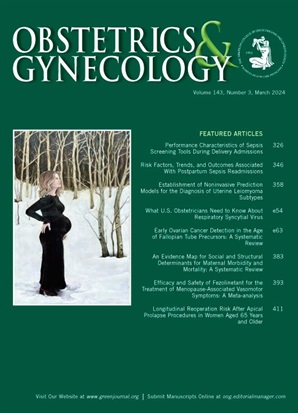Platelet-Rich Plasma for Genitourinary Syndrome of Menopause in Breast Cancer Survivors.
IF 4.7
2区 医学
Q1 OBSTETRICS & GYNECOLOGY
引用次数: 0
Abstract
OBJECTIVE To assess the safety and feasibility of injection of autologous platelet-rich plasma (PRP) into the vagina and posterior fourchette and to evaluate 6-month efficacy for treatment of genitourinary syndrome of menopause (GSM) in breast cancer survivors. METHODS We conducted a prospective, single-arm pilot study of breast cancer survivors (stage 0-III) who reported vaginal dryness with or without dyspareunia. Participants underwent a one-time treatment with 7 mL autologous PRP injected throughout the vaginal canal and posterior fourchette into 35 sites. The primary outcome was to assess safety and feasibility. Secondary outcomes included VMI (Vaginal Maturation Index), VHI (Vaginal Health Index), VAS/VuAS (Vaginal and Vulvar Assessment Scales), DIVA (Day-to-Day Impact of Vaginal Aging questionnaire), FSFI (Female Sexual Function Index), and UDI-6 (Urogenital Distress Inventory-Short Form) scores. Vaginal caliber was measured with silicone dilators. Patient Global Impression of Improvement (PGI-I) was assessed with a 7-point Likert scale. RESULTS Twenty participants were treated; mean±SD age and body mass index (BMI) were 53.6±7.5 years and 27.2±4.6, respectively. Most had hormone receptor-positive breast cancer (85.0%), and of those, 65.0% were taking an aromatase inhibitor. All participants completed the planned protocol. Treatment adverse events included vaginal spotting, irritation, discharge, burning, cramping, and mild pain, all resolving within 24 hours. No serious adverse events occurred. VAS/VuAS, FSFI, UDI-6, DIVA, VHI, and total scores showed significant improvement from baseline to 6 months; the VMI change was nonsignificant. At 6 months, 90.0% of patients had an increase in vaginal caliber as measured by change in dilator size, and 95.0% noted improvement of symptoms on PGI-I. CONCLUSION A single treatment of autologous PRP injected diffusely through the vaginal canal and posterior fourchette is safe and feasible. In this uncontrolled pilot trial, at 6 months, treatment significantly improved GSM symptoms, sexual function, urinary symptoms, and quality of life in breast cancer survivors, including those on aromatase inhibitors. CLINICAL TRIAL REGISTRATION ClnicalTrials.gov, NCT04535323; Cancer.gov, NCT04535323.富血小板血浆对乳腺癌幸存者绝经期泌尿生殖系统综合征的影响。
目的评价自体富血小板血浆(PRP)经阴道和子宫后腔注射治疗乳腺癌幸存者绝经期泌尿生殖系统综合征(GSM) 6个月的疗效和安全性。方法:我们进行了一项前瞻性单臂试点研究,研究对象为报告阴道干燥伴或不伴性交困难的乳腺癌幸存者(0-III期)。参与者接受一次性治疗,7毫升自体PRP通过阴道管和后四切注射到35个部位。主要结局是评估安全性和可行性。次要结局包括VMI(阴道成熟指数)、VHI(阴道健康指数)、VAS/VuAS(阴道和外阴评估量表)、DIVA(阴道衰老的日常影响问卷)、FSFI(女性性功能指数)和UDI-6(泌尿生殖窘迫量表-短表)评分。用硅胶扩张器测量阴道直径。采用7分Likert量表评估患者整体改善印象(PGI-I)。结果治疗20例;平均±SD年龄为53.6±7.5岁,体重指数为27.2±4.6岁。大多数患有激素受体阳性乳腺癌(85.0%),其中65.0%正在服用芳香酶抑制剂。所有参与者都完成了计划的方案。治疗不良事件包括阴道点滴、刺激、分泌物、灼烧、痉挛和轻度疼痛,均在24小时内消退。未发生严重不良事件。VAS/ VAS、FSFI、UDI-6、DIVA、VHI和总分从基线到6个月均有显著改善;VMI变化不显著。在6个月时,90.0%的患者通过扩张器大小的变化测量阴道口径增加,95.0%的患者注意到PGI-I症状的改善。结论自体PRP经阴道经后尿道扩散注射是一种安全可行的治疗方法。在这项未控制的试点试验中,治疗在6个月时显著改善了GSM症状、性功能、泌尿系统症状和乳腺癌幸存者的生活质量,包括那些使用芳香酶抑制剂的患者。临床试验注册:clinicaltrials .gov, NCT04535323;Cancer.gov NCT04535323。
本文章由计算机程序翻译,如有差异,请以英文原文为准。
求助全文
约1分钟内获得全文
求助全文
来源期刊

Obstetrics and gynecology
医学-妇产科学
CiteScore
11.10
自引率
4.20%
发文量
867
审稿时长
1 months
期刊介绍:
"Obstetrics & Gynecology," affectionately known as "The Green Journal," is the official publication of the American College of Obstetricians and Gynecologists (ACOG). Since its inception in 1953, the journal has been dedicated to advancing the clinical practice of obstetrics and gynecology, as well as related fields. The journal's mission is to promote excellence in these areas by publishing a diverse range of articles that cover translational and clinical topics.
"Obstetrics & Gynecology" provides a platform for the dissemination of evidence-based research, clinical guidelines, and expert opinions that are essential for the continuous improvement of women's health care. The journal's content is designed to inform and educate obstetricians, gynecologists, and other healthcare professionals, ensuring that they stay abreast of the latest developments and best practices in their field.
 求助内容:
求助内容: 应助结果提醒方式:
应助结果提醒方式:


